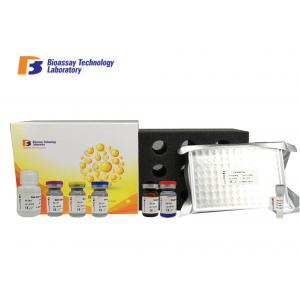Strong Sensitivity Rat Kidney Injury Molecule 1 ELISA Kit High Specificity Rat KIM-1 ELISA Kit
Add to Cart

Strong Sensitivity Rat Kidney Injury Molecule 1 ELISA Kit High Specificity Rat KIM-1 ELISA Kit
Cat.No E0549Ra
Standard Curve Range: 0.05ng/ml - 10ng/ml
Sensitivity: 0.01ng/ml
*This product is for research use only, not for use in diagnosis procedures. It’s highly recommend to read this instruction entirely before use.
Intended Use
This sandwich kit is for the accurate quantitative detection of Rat Kidney Injury Molecule 1 (also known as KIM-1) in serum, plasma, cell culture supernates, cell lysates, tissue homogenates.
Assay Principle
This kit is an Enzyme-Linked Immunosorbent Assay (ELISA). The plate has been pre-coated with Rat KIM-1 antibody. KIM-1 present in the sample is added and binds to antibodies coated on the wells. And then biotinylated Rat KIM-1 Antibody is added and binds to KIM-1 in the sample. Then Streptavidin-HRP is added and binds to the Biotinylated KIM-1 antibody. After incubation unbound Streptavidin-HRP is washed away during a washing step. Substrate solution is then added and color develops in proportion to the amount of Rat KIM-1. The reaction is terminated by addition of acidic stop solution and absorbance is measured at 450 nm.
Reagent Provided
| Components | Quantity |
| Standard Solution (12.8ng/ml) | 0.5ml x1 |
| Pre-coated ELISA Plate | 12 * 8 well strips x1 |
| Standard Diluent | 3ml x1 |
| Streptavidin-HRP | 6ml x1 |
| Stop Solution | 6ml x1 |
| Substrate Solution A | 6ml x1 |
| Substrate Solution B | 6ml x1 |
| Wash Buffer Concentrate (30x) | 20ml x1 |
| Biotinylated Rat KIM-1 Antibody | 1ml x1 |
| User Instruction | 1 |
| Plate Sealer | 2 pics |
| Zipper bag | 1 pic |
Specimen Collection
Serum Allow serum to clot for 10-20 minutes at room temperature. Centrifuge at 2000-3000 RPM for 20 minutes.
Plasma Collect plasma using EDTA or heparin as an anticoagulant. Centrifuge samples for 15 minutes at 2000-3000 RPM at 2 - 8°C within 30 minutes of collection.
Urine Collect by sterile tube. Centrifuge at 2000-3000 RPM for approximately 20 minutes. When collecting pleuroperitoneal fluid and cerebrospinal fluid, please follow the procedures above-mentioned.
Cell Culture Supernatant Collect by sterile tubes when examining secrete components. Centrifuge at 2000-3000 RPM for approximately 20 minutes. Collect the supernatants carefully. When examining the components within the cell, use PBS (pH 7.2-7.4) to dilute cell suspension to the cell concentration of approximately 1 million/ml. Damage cells through repeated freeze-thaw cycles to let out the inside components. Centrifuge at 2000-3000 RPM for approximately 20 minutes.
Tissue Rinse tissues in PBS (pH 7.4) to remove excess blood thoroughly and weigh before homogenization. Mince tissues and homogenize them in PBS (pH7.4) with a glass homogenizer on ice. Thaw at 2-8°C or freeze at -20°C. Centrifuge at 2000-3000 RPM for approximately 20 minutes.
*Sample can't be diluted with this kit. Owing to the the material we use to prepare the kit, the sample matrix interference may falsely depress the specificity and accuracy of the assay.
Assay Procedure
1. Prepare all reagents, standard solutions and samples as instructed. Bring all reagents to room temperature before use. The assay is performed at room temperature.
2. Determine the number of strips required for the assay. Insert the strips in the frames for use. The unused strips should be stored at 2-8°C.
3. Add 50μl standard to standard well. Note: Don’t add antibody to standard well because the standard solution contains biotinylated antibody.
4. Add 40μl sample to sample wells and then add 10μl anti-KIM-1 antibody to sample wells, then add 50μl streptavidin-HRP to sample wells and standard wells ( Not blank control well ). Mix well. Cover the plate with a sealer. Incubate 60 minutes at 37°C.
5. Remove the sealer and wash the plate 5 times with wash buffer. Soak wells with at least 0.35 ml wash buffer for 30 seconds to 1 minute for each wash. For automated washing, aspirate all wells and wash 5 times with wash buffer, overfilling wells with wash buffer. Blot the plate onto paper towels or other absorbent material.
6. Add 50μl substrate solution A to each well and then add 50μl substrate solution B to each well. Incubate plate covered with a new sealer for 10 minutes at 37°C in the dark.
7. Add 50μl Stop Solution to each well, the blue color will change into yellow immediately.
8. Determine the optical density (OD value) of each well immediately using a microplate reader set to 450 nm within 10 minuets after adding the stop solution.
Summary
1. Prepare all reagents, samples and standards.
2. Add sample and ELISA reagent into each well. Incubate for 1 hour at 37°C.
3. Wash the plate 5 times.
4. Add substrate solution A and B. Incubate for 10 minutes at 37°C.
5. Add stop solution and color develops.
6. Read the OD value within 10 minutes.
Referances
"Structural equation modeling highlights the potential of Kim-1 as
a biomarker for chronic kidney disease."
Gardiner L., Akintola A., Chen G., Catania J.M., Vaidya V.,
Burghardt R.C., Bonventre J.V., Trzeciakowski J., Parrish A.R.
Am. J. Nephrol. 35:152-163(2012)


